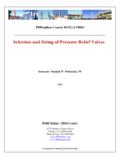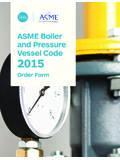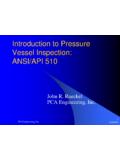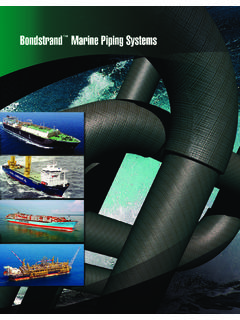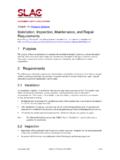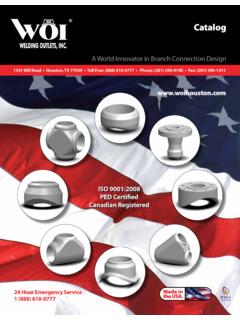Transcription of Safety requirements for pressure testing GS4
1 Health and Safety Executive Safety requirements for pressure testing Guidance Note GS4 (Fourth edition). Introduction 1 pressure testing involves applying stored energy to an assembly of parts, in order to verify its strength, its integrity and/or its functionality. 2 This guidance is aimed at all employers, supervisors and managers responsible for pressure testing . It has been revised in response to two fatalities in the UK since 2005 resulting from failure to correctly provide and maintain test fittings. The test engineers were struck by components ejected during the test. 3 This guidance addresses safe systems of work, safeguarding and maintenance. Action required 4 pressure testing is covered by the Provision and Use of Work Equipment Regulations 1998 (PUWER).
2 1. 5 The action you need to take to comply with these regulations will depend primarily on: the size of assembly under test;. its test pressure ;. the test medium. 6 Key issues relevant to all pressure testing activities are: determining risks;. preparing a written safe system of work;. segregating the item under test;. maintaining test connectors. Determining risks 7 pressure testing is a high-risk activity. When applying stored energy to an assembly, especially for the first time, there is potential for an unintended or premature pressure release while people are in the danger zone. 8 Release of stored energy under pressure can cause: test assembly rupture, creating flying fragments;. component or connector failure, creating missiles projected under force.
3 Test hose failure including detachment, with consequential hose whip, striking people;. sudden release of the test medium (liquid, gas, vapour, dust or other substance under pressure ) causing injury, eg burns, eye damage or pressure injection into bodily tissue. Page 1 of 9. Health and Safety Executive Test assembly rupture 9 It is essential to evaluate the stored energy in the assembly under test and identify the areas that could result in its unintended release. 10 The potential risk from fragments and missiles must be assessed. This can be calculated by referring to HSL research report (CRR 168/1998),2 which includes further information on theoretical calculations relating to blast energy. 11 You must assess the locations of the test assembly and of the controls for regulating pressure as part of the test.
4 The testing location must either be sufficiently remote that there is no risk to people, or a form of enclosure must be provided to contain the unintended release of stored energy. 12 Any enclosure must be sufficiently strong to contain an uncontrolled release of energy. Enclosure strength can be calculated (see CRR 168/1998)2 or, as a guide, use a minimum thickness of 3 mm mild steel plate. 13 Identify which part of the assembly is being tested is it the whole system, and does the test relate to a repair of an existing assembly, replacement part, removal or addition of connectors (including seal replacement)? 14 Identify whether inspection for leaks is necessary. Can this be done remotely, or are additional safeguards and inspection techniques necessary?
5 15 To reduce the stored energy in the assembly during a test, pressurise with water (or other fluid) rather than a gas wherever possible. 16 The volume of pressurised fluid used in a test should also be reduced where possible. This may be achieved by placing metal balls or other loosely fitting pieces within the test assembly. Ensure that any such pieces do not prevent the correct pressure from reaching all test areas, or affect the fatigue life of the components (eg by shot peening the surfaces). 17 The volume of pressurised fluid used when testing pipework, may be reduced with blank inserts ( spades'). These are used for pressurising and testing in-turn the individual sections of a system. 18 When an assembly has been repaired or modified the overall assembly will have already undergone a pressure test.
6 However, you must determine how the system characteristics could have been affected and what possible failure points could have been created by the work being carried out. Component or connector failure 19 Deterioration in the leading threads of connectors can reduce the remaining thread contact area sufficiently for it to fail under pressure with a sudden energy release. Typically, this takes place in test fittings and blanks (as these tend to be frequently tightened and released during pressure testing operations). 20 All test connectors are subject to cyclic loading, both from the pressure test application and from tightening torque loadings. Fatigue is a factor that must be addressed when test connectors are being inspected and assessed for continued use.
7 Some signs of fatigue are clearly visible and measurable (deformed threads), and some are not. 21 When pressure is released from a compressed gas the gas will cool quite significantly. This will cause localised contraction in connectors and other structural components, creating additional risk (especially if different materials are involved). Safety requirements for pressure testing Page 2 of 9. Health and Safety Executive Test hose failure 22 Test hoses can also deteriorate, leading to release of fluid. This often occurs from incorrect lengths of hose being used, where bend radius is too small, or hoses being stretched and twisted. Mechanical damage is also a significant cause of hose deterioration. 23 A similar risk of thread deterioration in the connecting hose fittings exists, described previously in paragraph 19.
8 This deterioration results in sudden disconnection of the hose and consequential hose whip. Sudden release of test medium 24 Contact with escaping fluids must be avoided. Risk assessment has to consider how leaks will be identified. 25 Fine streams of escaping pressurised fluid can penetrate skin and enter the body. These fluid injections can cause severe tissue damage and loss of limb. It only takes 7 bar (100 psi) to penetrate the skin surface. 26 If a fluid-injection accident occurs, you must seek medical treatment by a doctor immediately. Any fluid injected into the skin must be surgically removed within a few hours, or gangrene can result (clause of ISO/ TR 17165-23 advises that doctors unfamiliar with hydraulic oil injection injury should consult a knowledgeable medical source).
9 Preparing a written safe system of work 27 A written safe system of work for pressure testing must be in place, summarising how the issues raised in this information sheet are to be dealt with. 28 The safe system of work provides written instructions to test engineers and requires sufficient information to ensure correct: test set-up;. selection of fittings;. carrying out the initial test;. checking for leaks;. supervision. Test set-up 29 Your written safe system of work must identify how each assembly under test can: be safely energised;. be safely monitored;. have the test medium evacuated. 30 Identify measures to prevent over-pressurising the test assembly. This is normally achieved by connecting a pressure relief valve onto the assembly under test.
10 31 To prevent/reduce operator presence in the danger zone, determine and identify optimum positions for control valves and monitoring devices such as pressure gauges and flow meters, locating them away from the test area. 32 State how pressure will be safely exhausted after a test, before entry into the danger zone. This is normally achieved by fitting a remote drain valve on the test apparatus away from the danger zone, plus a pressure gauge downstream from Safety requirements for pressure testing Page 3 of 9. Health and Safety Executive the assembly under test, to verify nil pressure . It must be safe to access the drain valve while the vessel or system is under pressure . 33 State how and where flexible hose assemblies including plastic piping in the case of pneumatic testing should be restrained or shielded to restrict whiplash hazard from failure (see clause of ISO/ TR 17165-2,3 clause of BS EN ISO 44134 and clause of BS EN ISO 44145).










